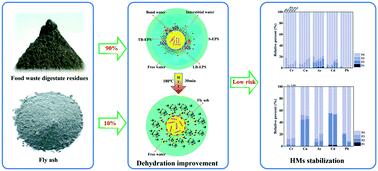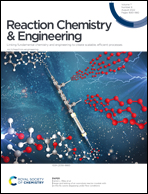Synergistic hydrothermal treatment of food waste digestate residues and incineration fly ash: dehydration performance and heavy metals safety†
Abstract
The poor dewaterability of digestate residues (DRs) and the toxicity of fly ash (FA) limit their processing and utilization at the recycling stage. Hydrothermal treatment is a promising technology for deep dehydration and detoxification of waste. In the present study, synergistic hydrothermal treatment (HTT) of DRs and FA was conducted to investigate the dehydration performance and heavy metals (HMs) safety. The results showed that 10 wt% FA maximized the dehydration performance of DRs and promoted the conversion of loosely bound extracellular polymeric substances (EPS) and tightly bound EPS to soluble EPS (S-EPS) which facilitated the removal of sticky S-EPS, resulting in a reduction in the normalized capillary suction time to 0.358 s L g−1 and an increase in solids content to 36.61 g per 100 g. Moreover, HTT promoted the conversion of HM fractions in solid products from bioavailable fractions to stable fractions and the potential ecological risks of solids were low. This study provided a cost-effective, efficient and safe process for co-treating DRs and FA with high application prospects.



 Please wait while we load your content...
Please wait while we load your content...